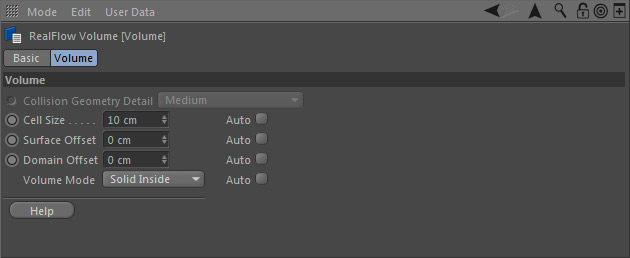Volume : Volume
Here you control how RealFlow | Cinema 4D "sees" an object and how it will be filled with particles.
Collision Geometry Detail
Here you find five levels of quality. The higher the level, the longer the simulation will take, but the fluid-object collision will also be more accurate. Changing the level influences and updates the "Cell Size" value found in the "Volume" section. In most cases, the calculated value provides the best balance between simulation speed and accuracy. If want to control "Cell Size" manually deactivate the associated "Auto" checkbox.
Cell Size
RealFlow | Cinema 4D's fluid and material engines are cell-based and therefore, colliding objects have to be rasterized internally. The smaller the cells, the better and more accurate the collision, but at the cost of longer simulation times. By default, "Cell Size" is calculated automatically based on the "Collision Geometry Detail" level. For manual control uncheck "Auto". With "Auto" turned off, "Cell size" can be animated. This allows you to refine collision detection over time and speed up the simulation, e.g. from coarse to accurate.
Surface Offset
This parameter creates a solid extension around the object and prevents the fluid from penetrating its surface:
- The offset can be visualized with Scene > Display > Show Collision Geometry
- Both positive and negative values are accepted.
Domain Offset
In order to improve fluid-object interaction you can increase this parameter. The effect is that the fluid will “see” the object earlier. This can be interesting for fast-moving fluids. By default, "Domain Offset" is calculated automatically based on the "Collision Geometry Detail" level. For manual control uncheck "Auto".
Volume Mode
Here are the three possible modes – you can read more about this topic under → "Adding Objects" and → "Filling Objects I".
- "Solid inside" makes the fluid collide with object's outer surface.
- "Solid outside" creates a hollow object and fluid interacts with the inner surface.
- "Shell" is normally used with open objects like glasses, vases, but also planes. When active, an invisible layer is added around the object's surface. The thickness of this layer is
Cell size * 3. As a consequence, there will always be a gap between the fluid and the object.
By default, "Volume Mode" is determined automatically by analyzing the object's geometry, but this test is not always reliable. For manual control uncheck "Auto". If you can see leaking particles in conjunction with thin or single-walled objects please consider activating → "Continuous Collision Detection" in the "Collider" tag.
